Abstract
Antigen-specific T-cell factors are mediator molecules which are produced by helper and suppressor T cells and which can perform the function of those cells in an antigen-specific manner. They probably play an important part in immunoregulation. The major histocompatibility complex has a controlling influence on their structure and activity, while their antigen-recognition properties may be conferred by immunoglobulin V regions. Interest in the factors derives from three related areas of research, namely (i) the problem of T-cell recognition of antigen; (ii) the mechanisms of cellular interactions in antibody production and cell-mediated immunity; and (iii) the genetic control of immune responses. This review discusses the literature up to June 1980 on their production, structure, genetic restriction and mechanism of action.
Full text
PDF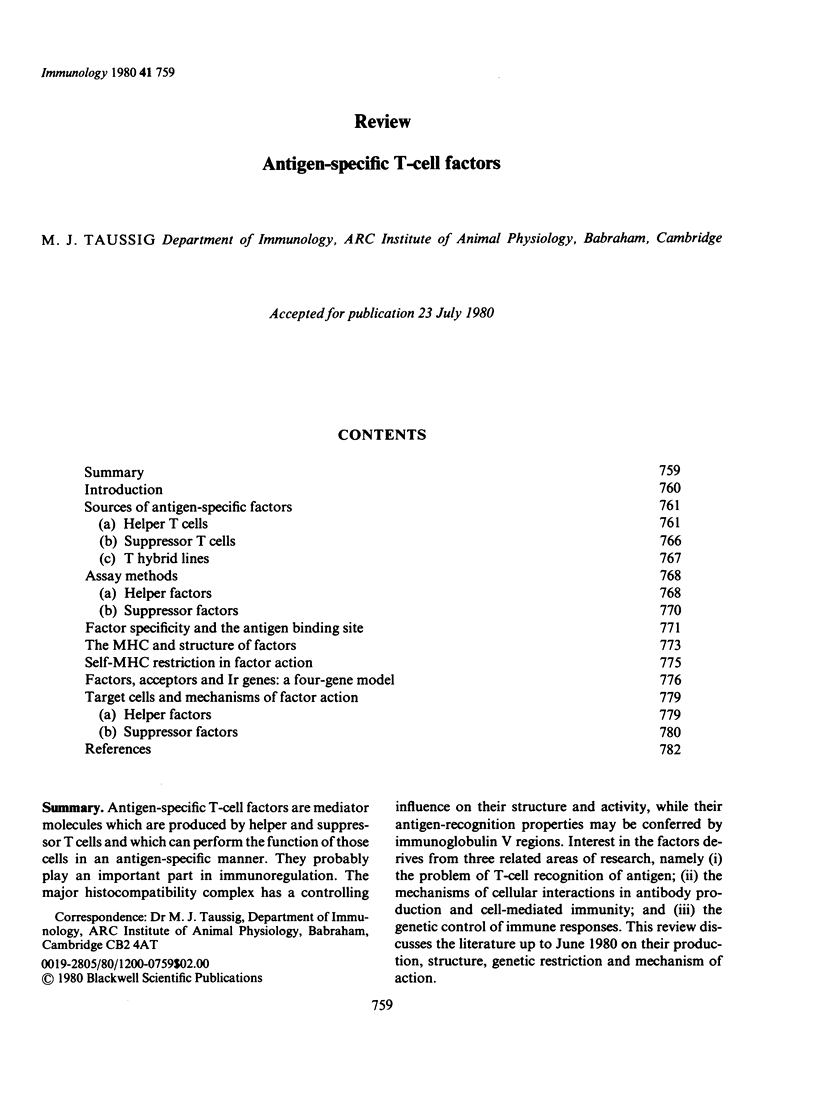
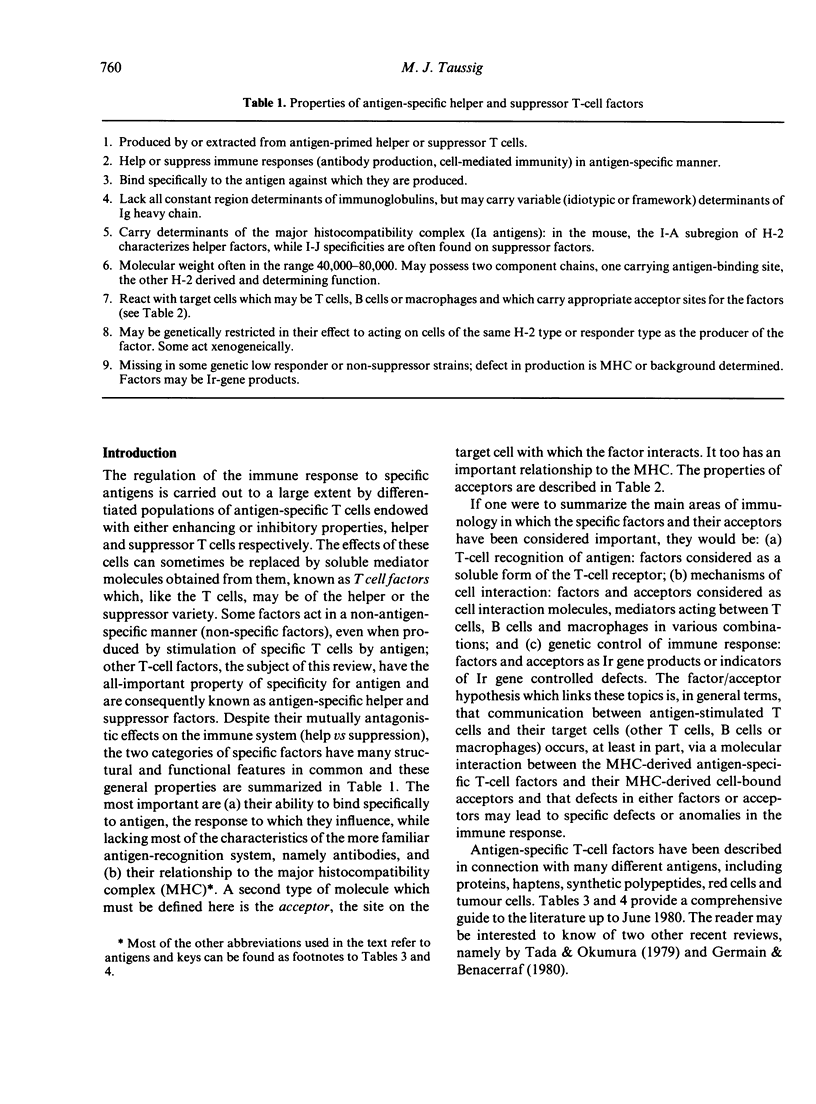
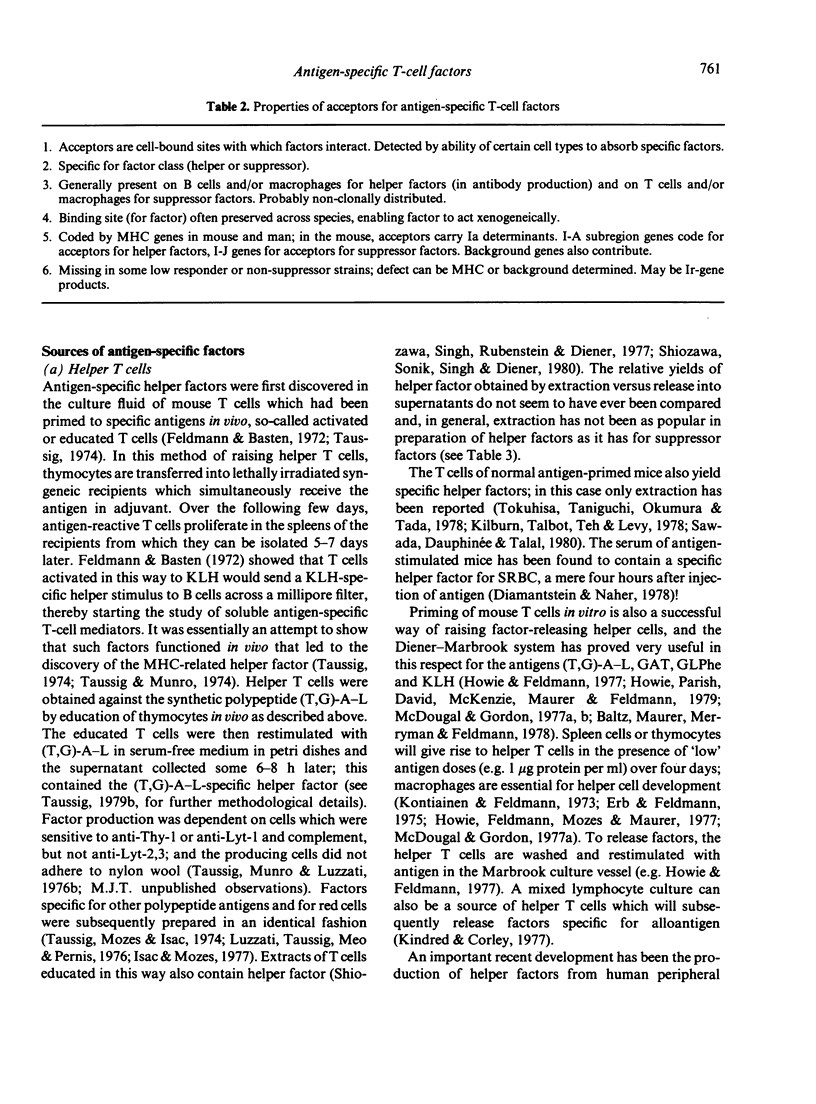
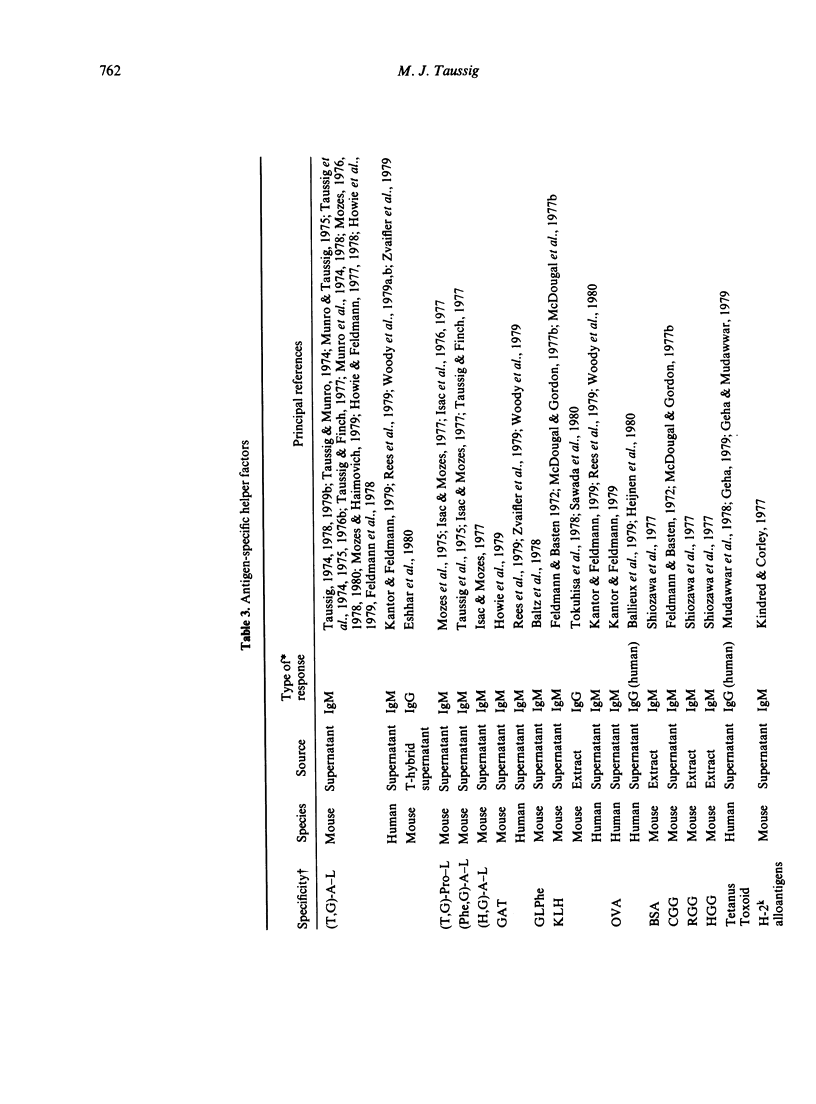

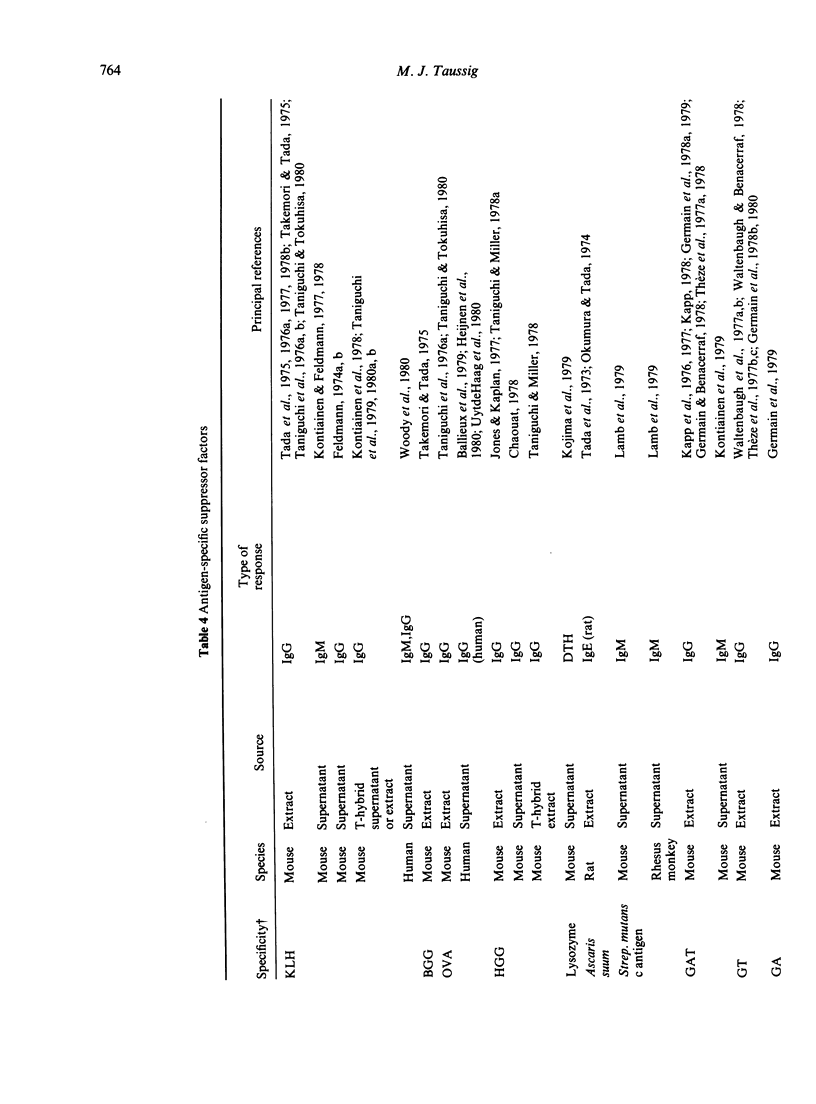
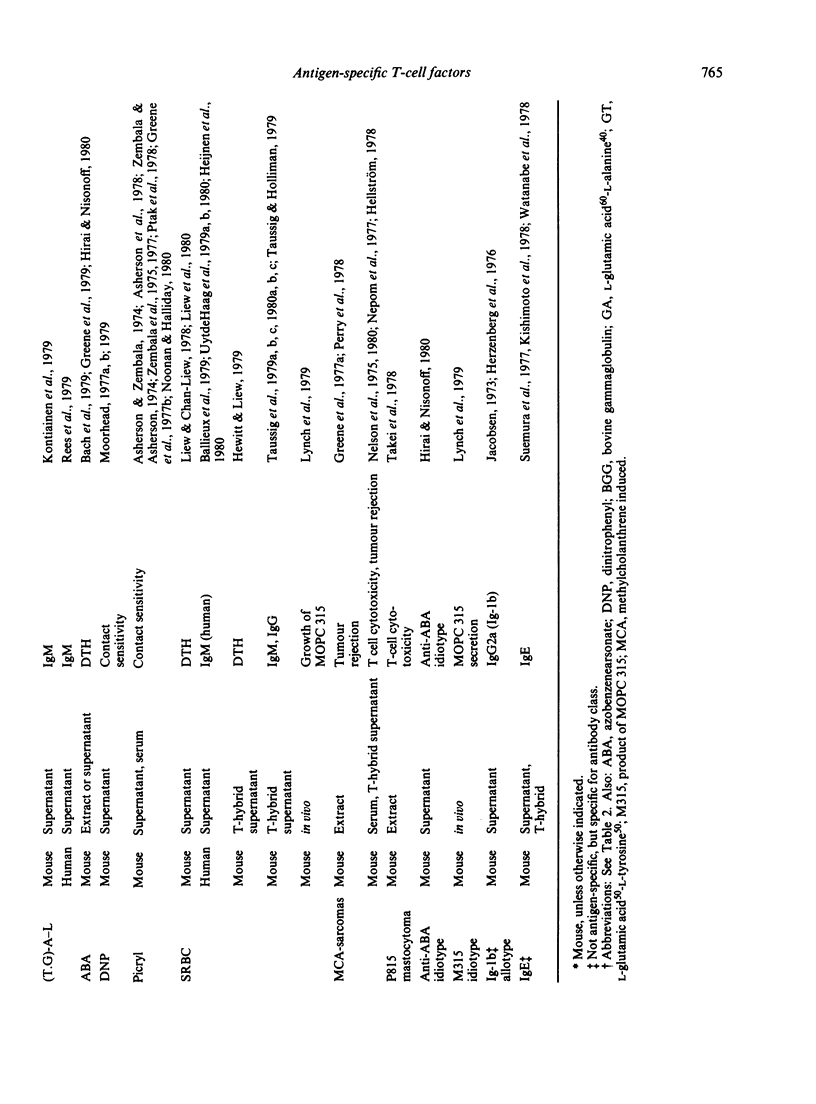
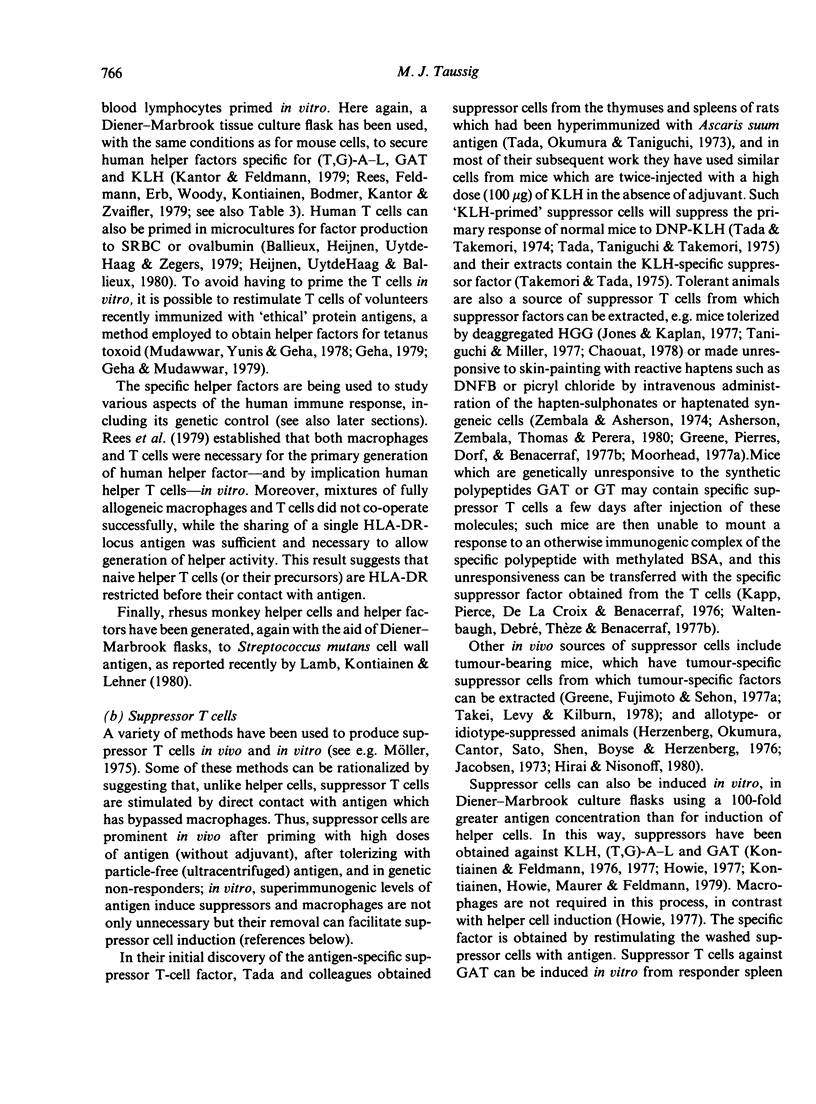
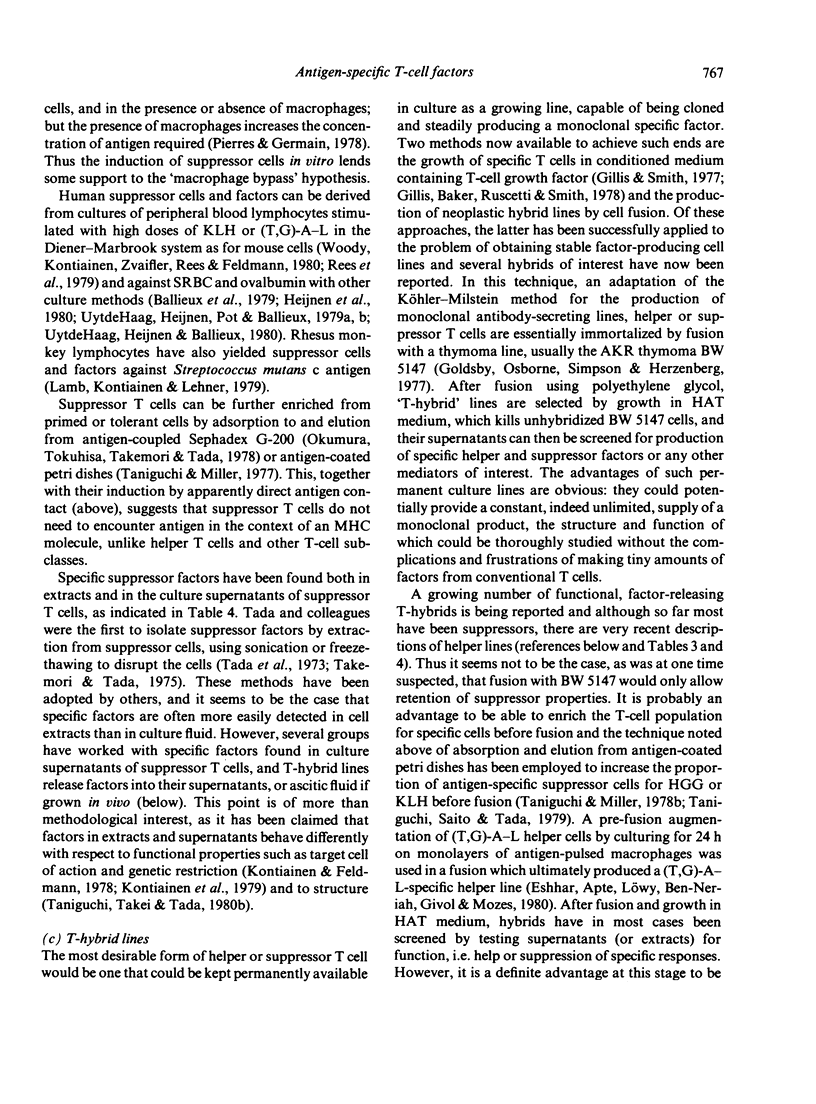
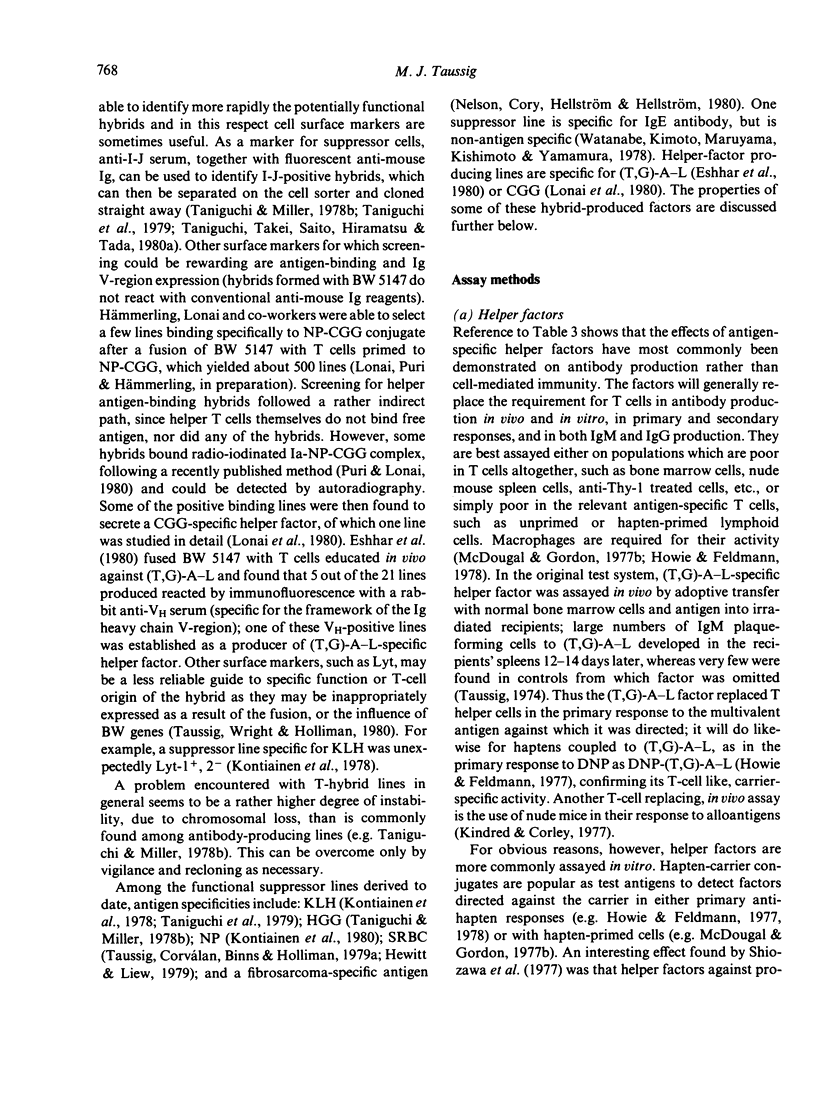
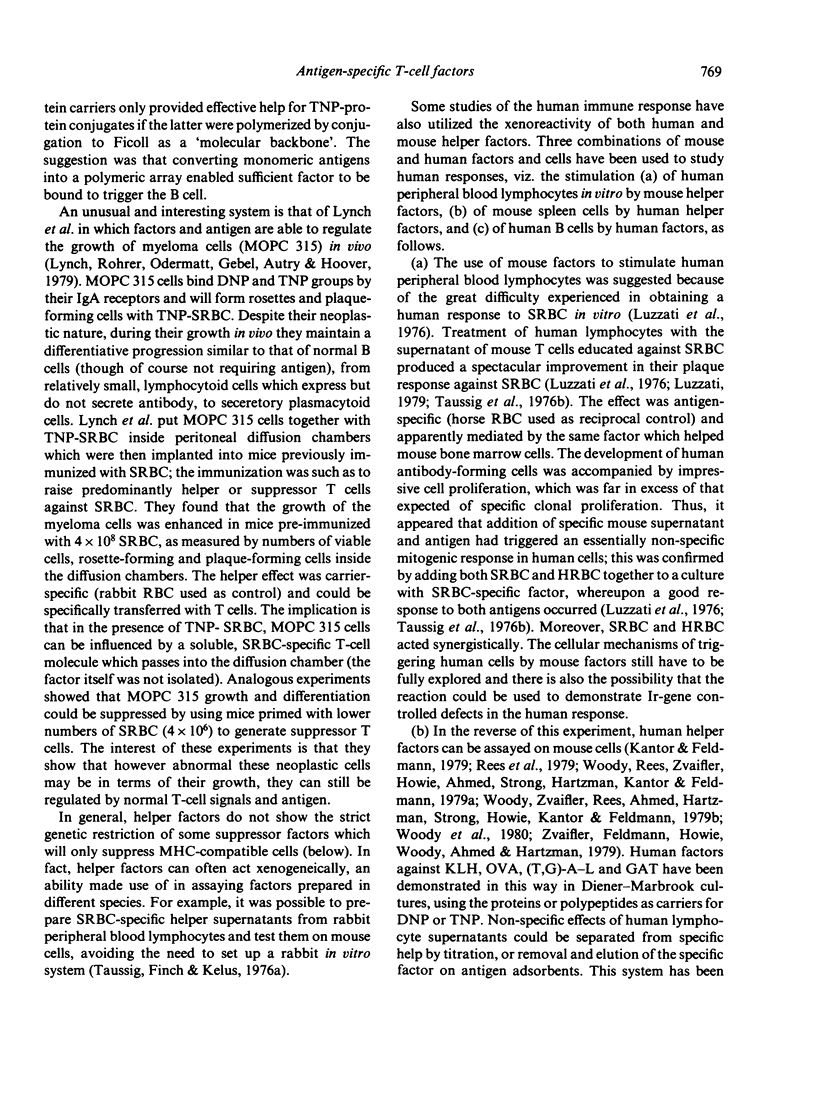

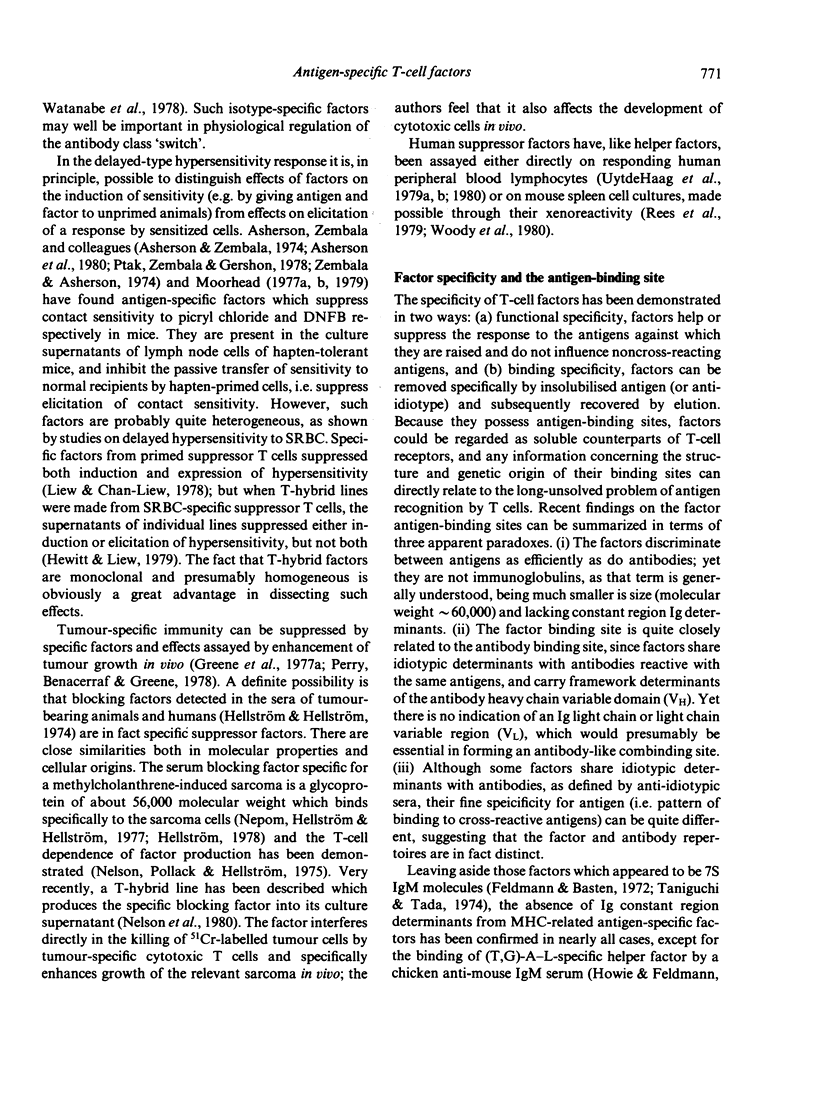

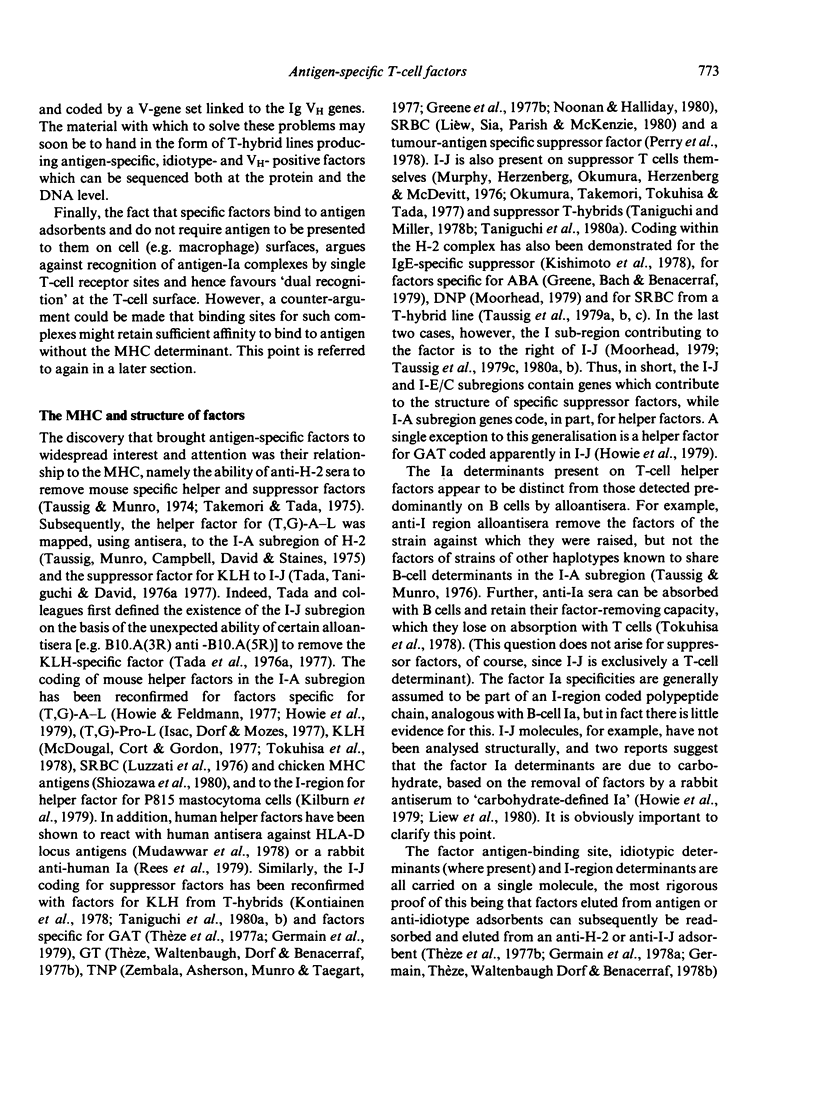
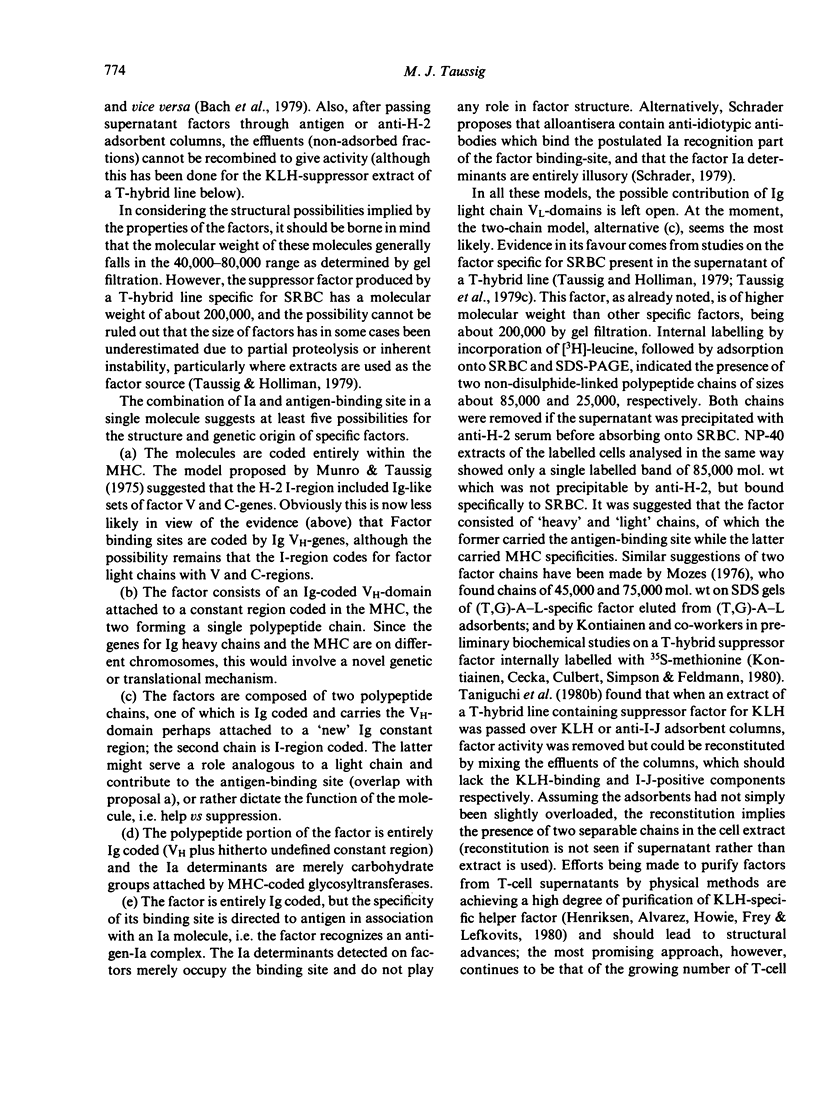
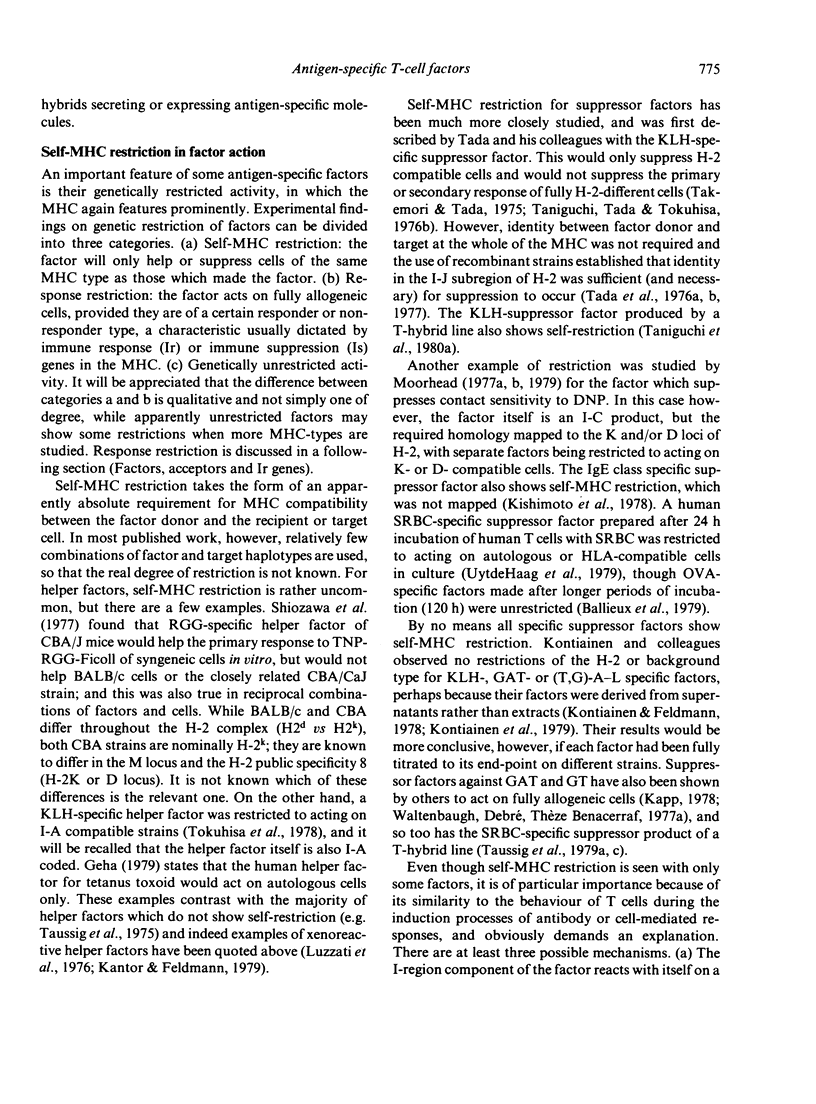

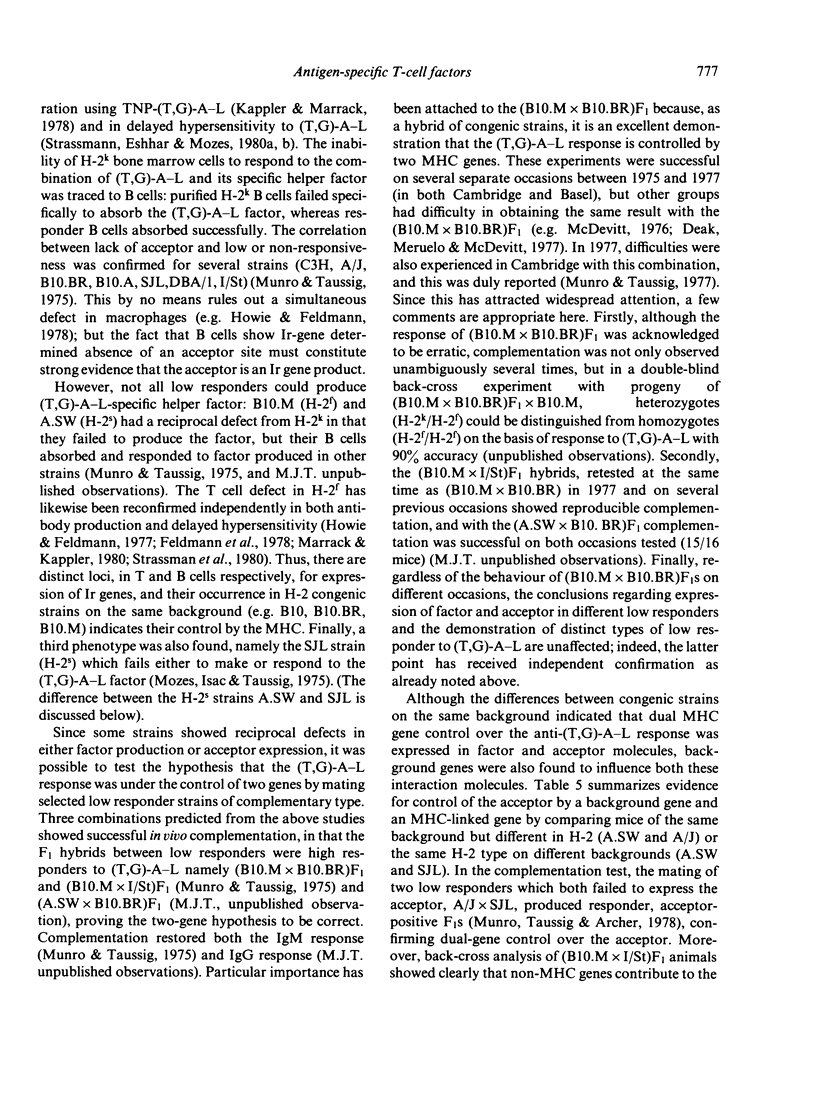

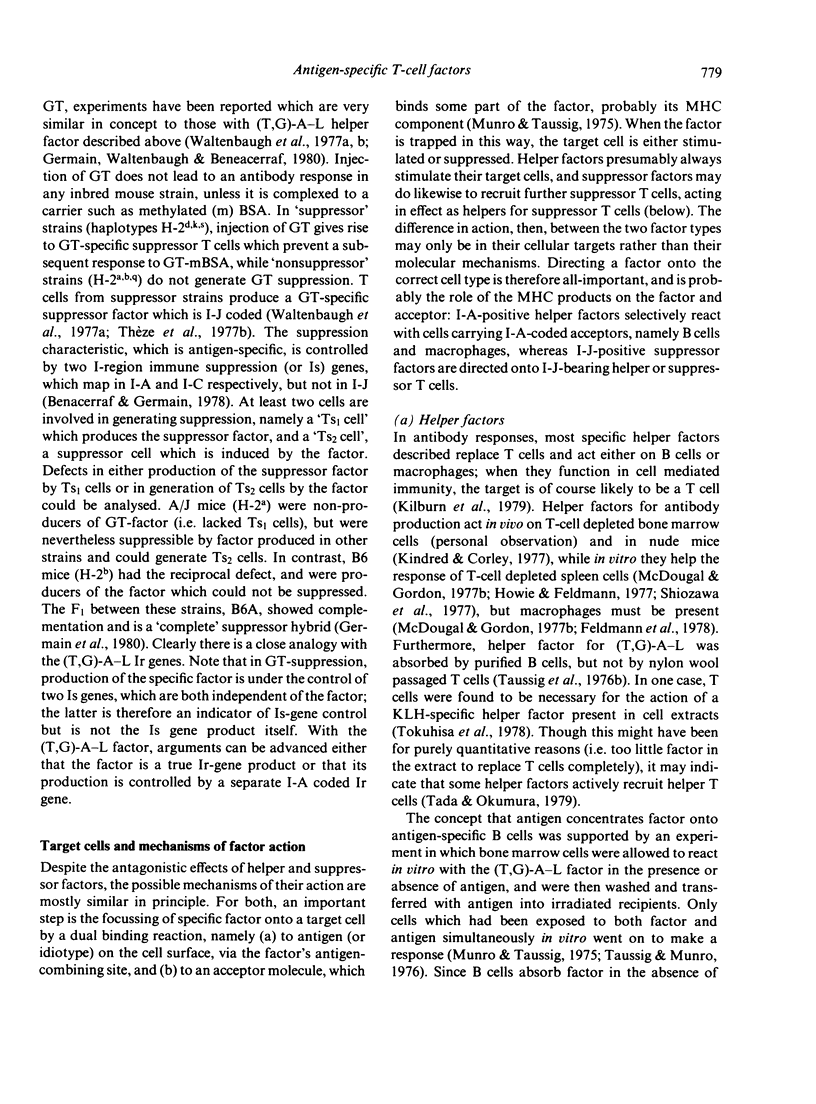
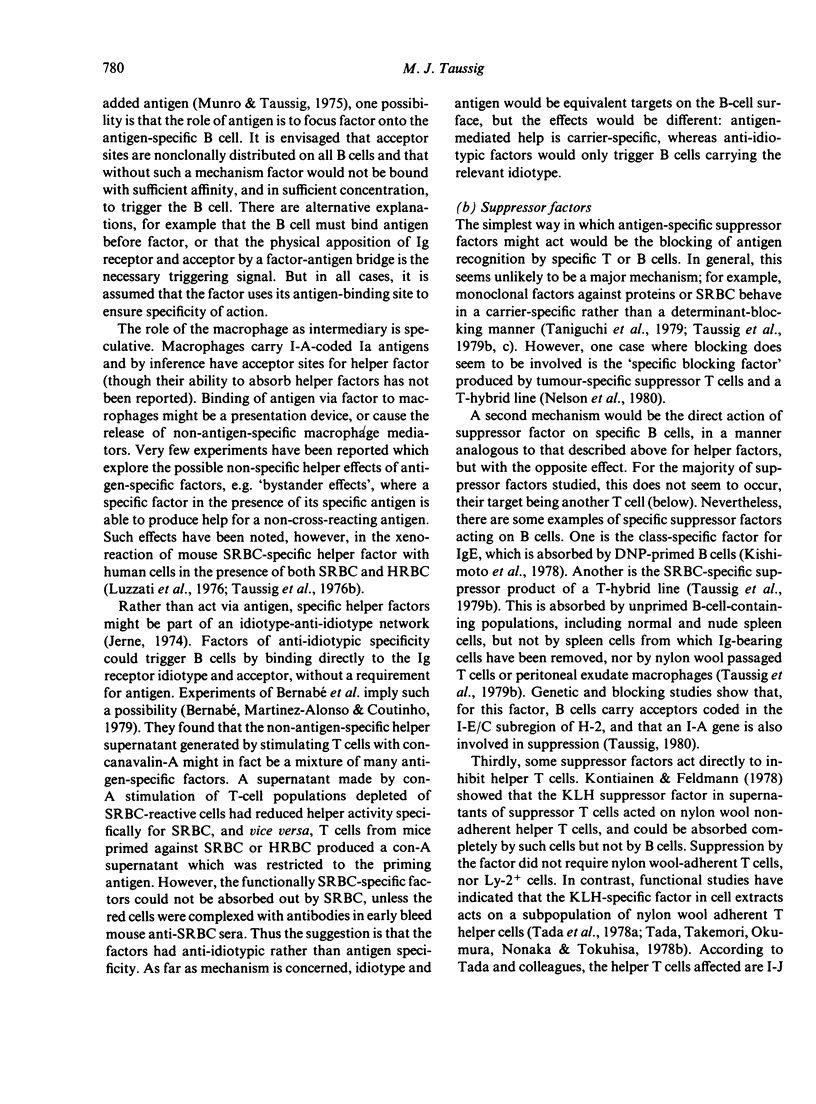
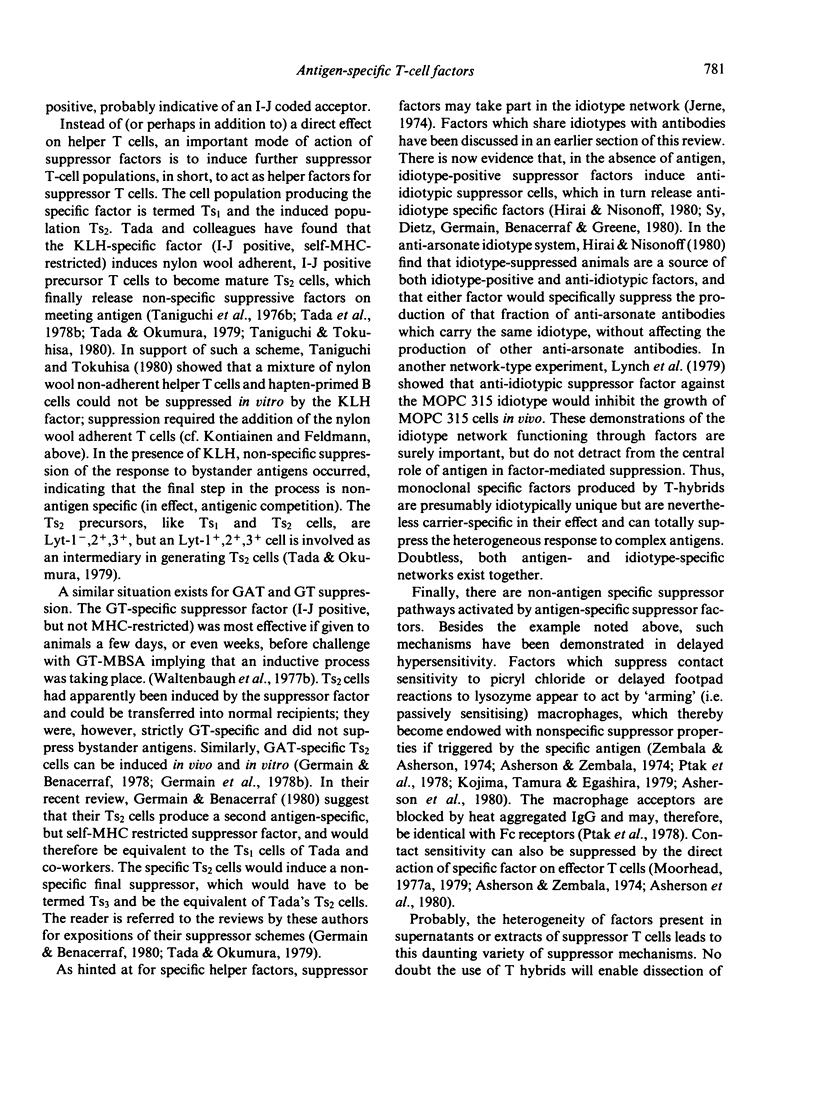
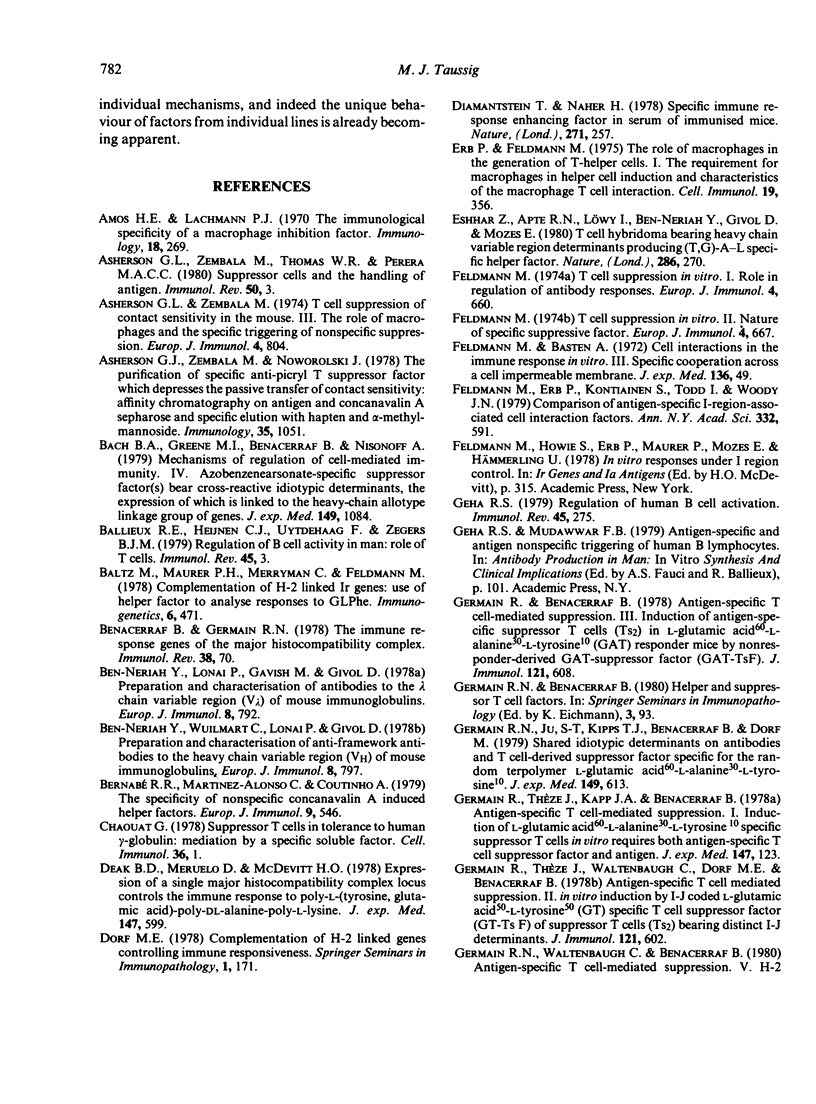
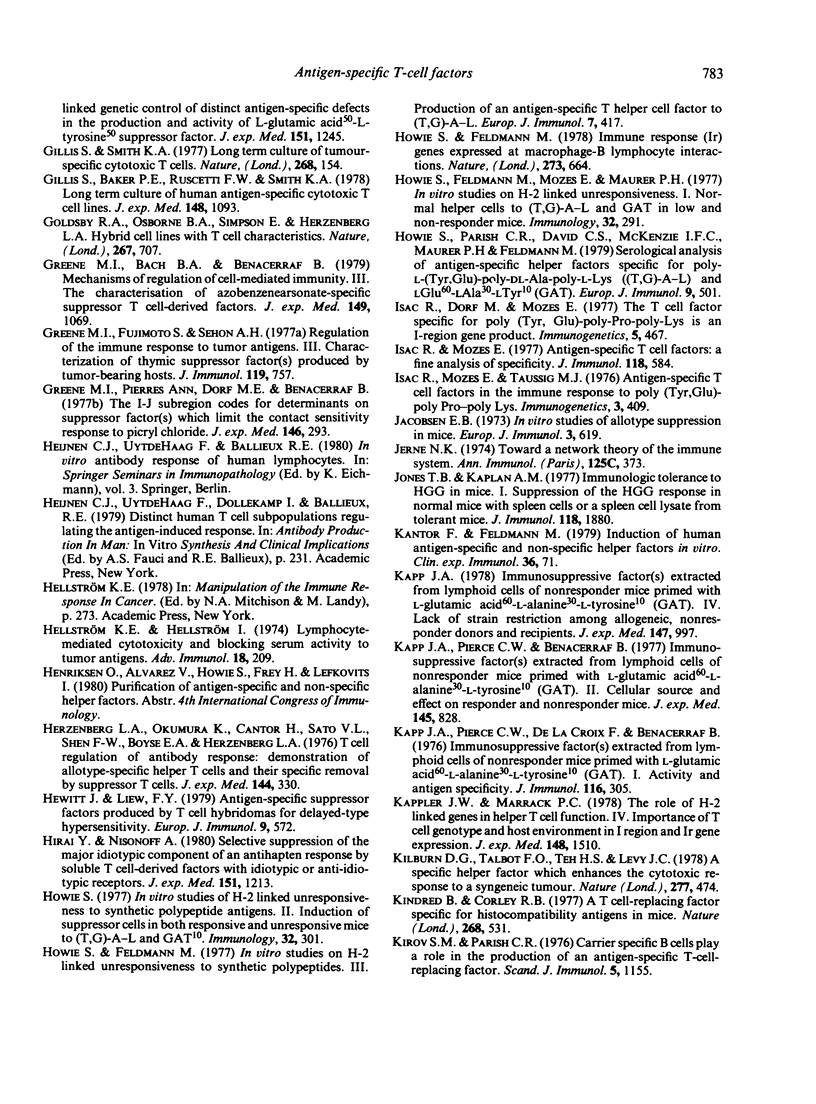
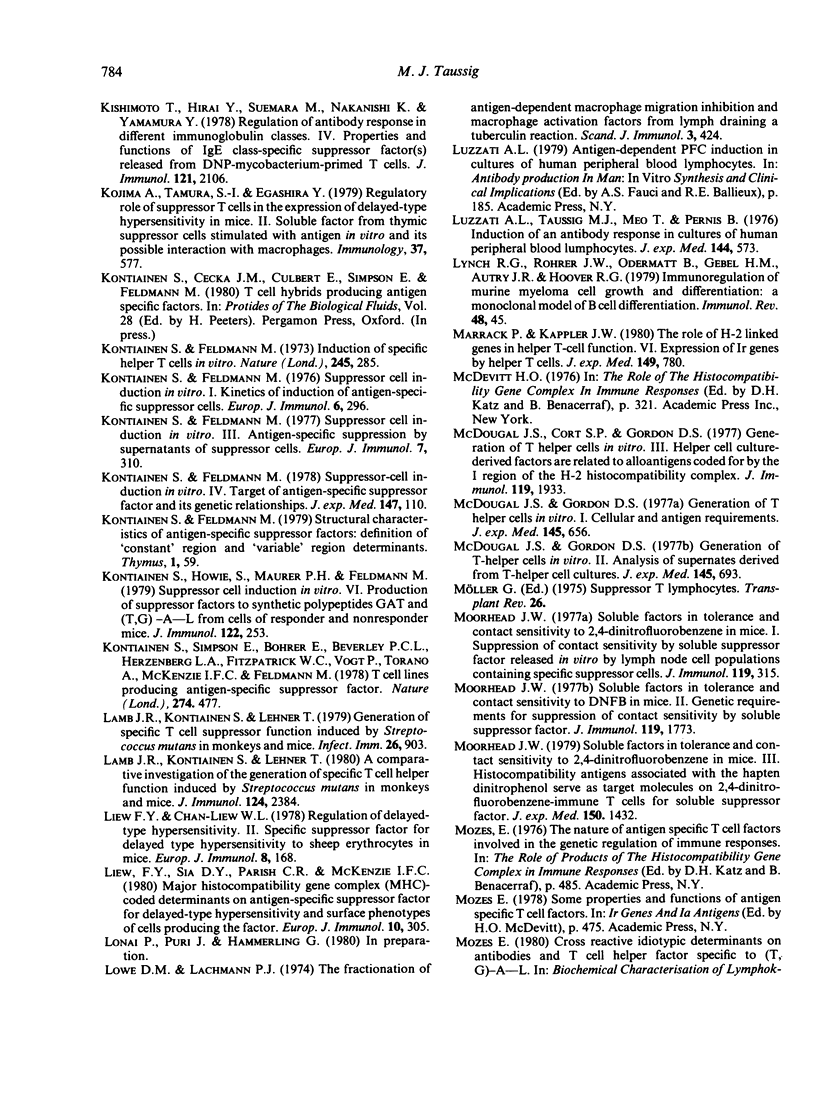
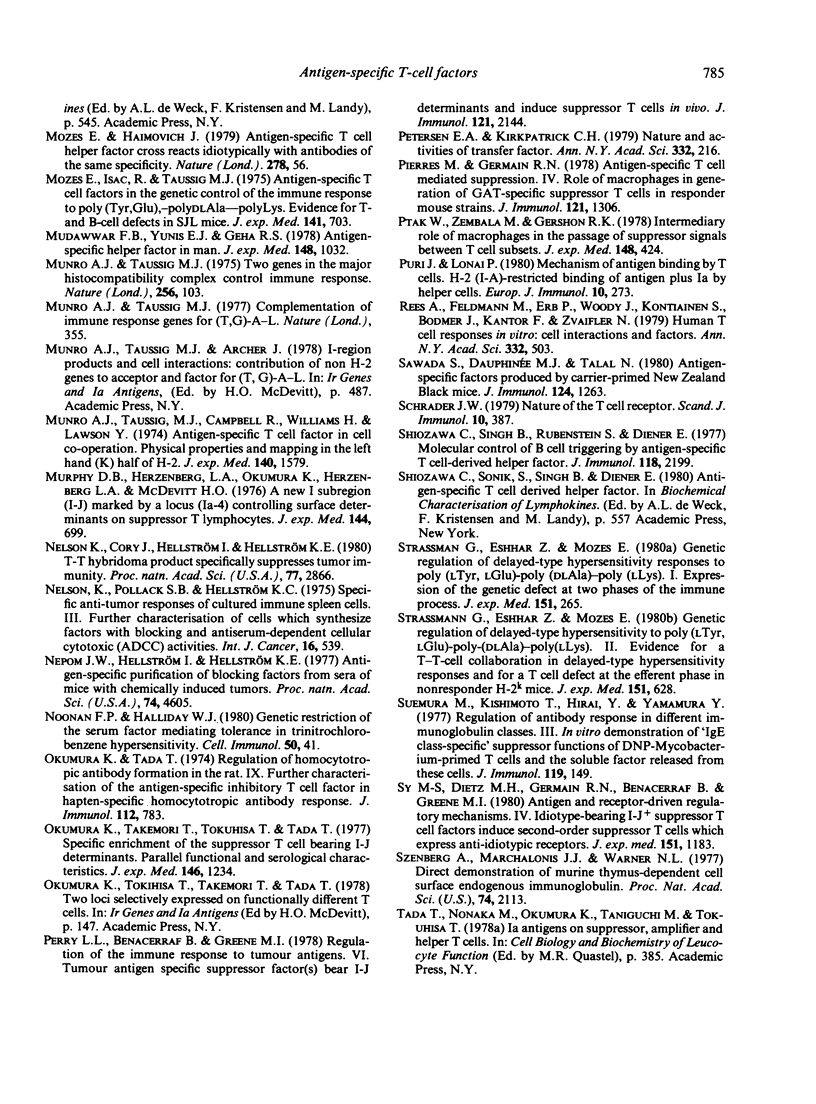

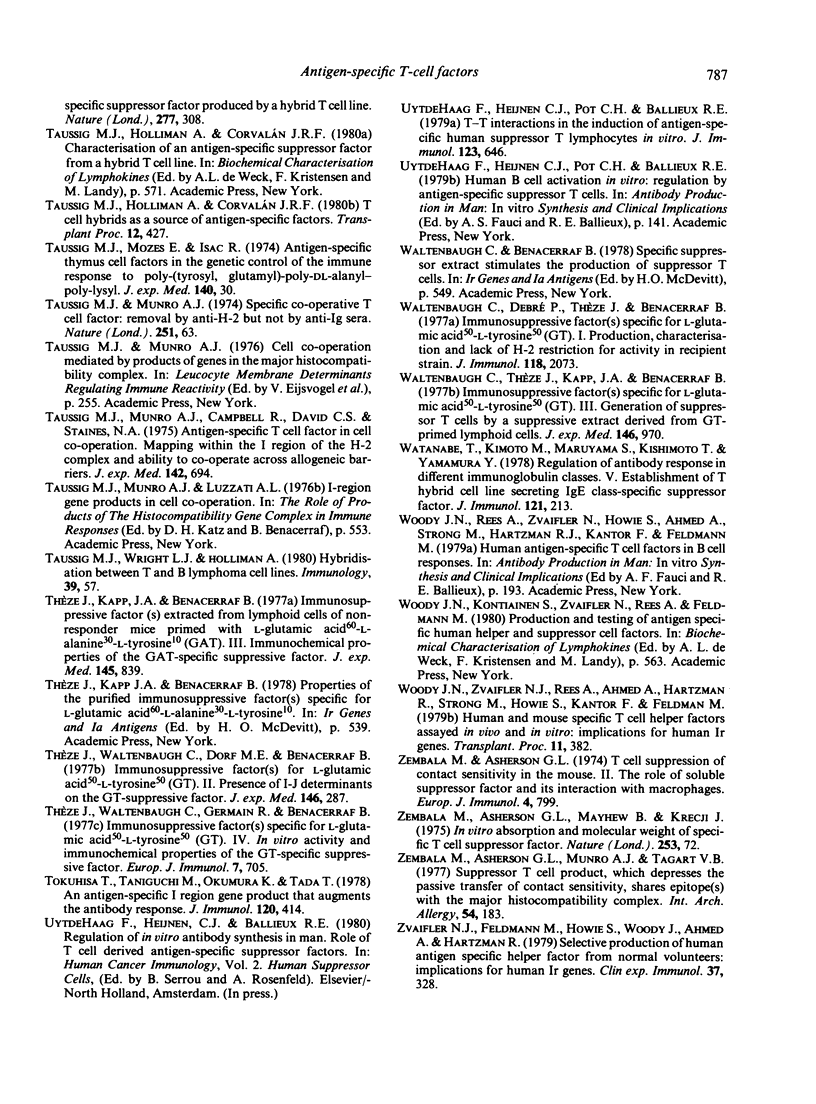
Selected References
These references are in PubMed. This may not be the complete list of references from this article.
- Amos H. E., Lachmann P. J. The immunological specificity of a macrophage inhibition factor. Immunology. 1970 Feb;18(2):269–278. [PMC free article] [PubMed] [Google Scholar]
- Asherson G. L., Zembala M., Noworolski J. The purification of specific anti-picryl T suppressor factor which depresses the passive transfer of contact sensitivity: affinity chromatography on antigen and Concanavalin A sepharose and specific elution with hapten and alpha-methylmannoside. Immunology. 1978 Dec;35(6):1051–1056. [PMC free article] [PubMed] [Google Scholar]
- Asherson G. L., Zembala M., Thomas W. R., Perera M. A. Suppressor cells and the handling of antigen. Immunol Rev. 1980;50:3–45. doi: 10.1111/j.1600-065x.1980.tb00306.x. [DOI] [PubMed] [Google Scholar]
- Bach B. A., Greene M. I., Benacerraf B., Nisonoff A. Mechanisms of regulation of cell-mediated immunity. IV. Azobenzenearsonate-specific suppressor factor(s) bear cross-reactive idiotypic determinants the expression of which is linked to the heavy-chain allotype linkage group of genes. J Exp Med. 1979 May 1;149(5):1084–1098. doi: 10.1084/jem.149.5.1084. [DOI] [PMC free article] [PubMed] [Google Scholar]
- Ballieux R. E., Heijnen C. J., Uytdehaag F., Zegers B. J. Regulation of B cell activity in man: role of T cells. Immunol Rev. 1979;45:3–39. doi: 10.1111/j.1600-065x.1979.tb00271.x. [DOI] [PubMed] [Google Scholar]
- Ben-Neriah Y., Lonai P., Gavish M., Givol D. Preparation and characterization of antibodies to the lambda chain variable region (Vlambda) of mouse immunoglobulins. Eur J Immunol. 1978 Nov;8(11):792–796. doi: 10.1002/eji.1830081108. [DOI] [PubMed] [Google Scholar]
- Ben-Neriah Y., Wuilmart C., Lonai P., Givol D. Preparation and characterization of anti-framework antibodies to the heavy chain variable region (VH) of mouse immunoglobulins. Eur J Immunol. 1978 Nov;8(11):797–801. doi: 10.1002/eji.1830081109. [DOI] [PubMed] [Google Scholar]
- Benacerraf B., Germain R. N. The immune response genes of the major histocompatibility complex. Immunol Rev. 1978;38:70–119. doi: 10.1111/j.1600-065x.1978.tb00385.x. [DOI] [PubMed] [Google Scholar]
- Bernabe R. R., Martinez-Alonso C., Coutinho A. The specificity of nonspecific concanavalin A-induced helper factors. Eur J Immunol. 1979 Jul;9(7):546–552. doi: 10.1002/eji.1830090710. [DOI] [PubMed] [Google Scholar]
- Cancro M. P., Sigal N. H., Klinman N. R. Differential expression of an equivalent clonotype among BALB/c and C57BL/6 mice. J Exp Med. 1978 Jan 1;147(1):1–12. doi: 10.1084/jem.147.1.1. [DOI] [PMC free article] [PubMed] [Google Scholar]
- Chaouat G. Suppressor T cells in tolerance to human gamma-globulin: mediation by a specific soluble factor. Cell Immunol. 1978 Mar 1;36(1):1–14. doi: 10.1016/0008-8749(78)90245-9. [DOI] [PubMed] [Google Scholar]
- Deak B. D., Meruelo D., McDevitt H. O. Expression of a single major histocompatibility complex locus controls the immune response to poly-L-(tyrosine, glutamic acid)-poly-DL-alanine-poly-L-lysine. J Exp Med. 1978 Feb 1;147(2):599–604. doi: 10.1084/jem.147.2.599. [DOI] [PMC free article] [PubMed] [Google Scholar]
- Diamanstein T., Naher H. Specific immune response enhancing factor in serum of immunised mice. Nature. 1978 Jan 19;271(5642):257–259. doi: 10.1038/271257a0. [DOI] [PubMed] [Google Scholar]
- Erb P., Feldmann M. The role of macrophages in the generation of T-helper cells. I. The requirement for macrophages in helper cell induction and characteristics of the macrophage-T cell interaction. Cell Immunol. 1975 Oct;19(2):356–367. doi: 10.1016/0008-8749(75)90217-8. [DOI] [PubMed] [Google Scholar]
- Eshhar Z., Apte R. N., Löwy I., Ben-Neriah Y., Givol D., Mozes E. T-cell hybridoma bearing heavy chain variable region determinants producing (T,G)-A--L-specific helper factor. Nature. 1980 Jul 17;286(5770):270–272. doi: 10.1038/286270a0. [DOI] [PubMed] [Google Scholar]
- Feldmann M., Basten A. Cell interactions in the immune response in vitro. 3. Specific collaboration across a cell impermeable membrane. J Exp Med. 1972 Jul 1;136(1):49–67. doi: 10.1084/jem.136.1.49. [DOI] [PMC free article] [PubMed] [Google Scholar]
- Feldmann M., Erb P., Kontiainen S., Todd I., Woody J. N. Comparison of antigen-specific I-region-associated cell interaction factors. Ann N Y Acad Sci. 1979;332:591–604. doi: 10.1111/j.1749-6632.1979.tb47153.x. [DOI] [PubMed] [Google Scholar]
- Feldmann M. T cell suppression in vitro. I. Role in regulation of antibody responses. Eur J Immunol. 1974 Oct;4(10):660–666. doi: 10.1002/eji.1830041005. [DOI] [PubMed] [Google Scholar]
- Feldmann M. T cell suppression in vitro. II. Nature of specific suppressive factor. Eur J Immunol. 1974 Oct;4(10):667–674. doi: 10.1002/eji.1830041006. [DOI] [PubMed] [Google Scholar]
- Geha R. S. Regulation of human B cell activation. Immunol Rev. 1979;45:275–305. doi: 10.1111/j.1600-065x.1979.tb00281.x. [DOI] [PubMed] [Google Scholar]
- Germain R. N., Ju S. T., Kipps T. J., Benacerraf B., Dorf M. E. Shared idiotypic determinants on antibodies and T-cell-derived suppressor factor specific for the random terpolymer L-glutamic acid60-L-alanine30-L-tyrosine10. J Exp Med. 1979 Mar 1;149(3):613–622. doi: 10.1084/jem.149.3.613. [DOI] [PMC free article] [PubMed] [Google Scholar]
- Germain R. N., Theze J., Waltenbaugh C., Dorf M. E., Benacerraf B. Antigen-specific T cell-mediated suppression. II. In vitro induction by I-J-coded L-glutamic acid50-L-tyrosine50 (GT)-specific T cell suppressor factor (GT-T8F) of suppressor T cells (T82) bearing distinct I-J determinants. J Immunol. 1978 Aug;121(2):602–607. [PubMed] [Google Scholar]
- Germain R. N., Thèze J., Kapp J. A., Benacerraf B. Antigen-specific T-cell-mediated suppression. I. Induction of L-glutamic acid60-L-alanine30-L-tyrosine10 specific suppressor T cells in vitro requires both antigen-specific T-cell-suppressor factor and antigen. J Exp Med. 1978 Jan 1;147(1):123–136. doi: 10.1084/jem.147.1.123. [DOI] [PMC free article] [PubMed] [Google Scholar]
- Germain R. N., Waltenbaugh C., Benacerraf B. Antigen-specific T cell-mediated suppression. V. H-2-linked genetic control of distinct antigen-specific defects in the production and activity of L-glutamic acid50-L-tyrosine50 suppressor factor. J Exp Med. 1980 May 1;151(5):1245–1259. doi: 10.1084/jem.151.5.1245. [DOI] [PMC free article] [PubMed] [Google Scholar]
- Gillis S., Baker P. E., Ruscetti F. W., Smith K. A. Long-term culture of human antigen-specific cytotoxic T-cell lines. J Exp Med. 1978 Oct 1;148(4):1093–1098. doi: 10.1084/jem.148.4.1093. [DOI] [PMC free article] [PubMed] [Google Scholar]
- Gillis S., Smith K. A. Long term culture of tumour-specific cytotoxic T cells. Nature. 1977 Jul 14;268(5616):154–156. doi: 10.1038/268154a0. [DOI] [PubMed] [Google Scholar]
- Greene M. I., Bach B. A., Benacerraf B. Mechanisms of regulation of cell-mediated immunity. III. The characterization of azobenzenearsonate-specific suppressor T-cell-derived-suppressor factors. J Exp Med. 1979 May 1;149(5):1069–1083. doi: 10.1084/jem.149.5.1069. [DOI] [PMC free article] [PubMed] [Google Scholar]
- Greene M. I., Fujimoto S., Sehon A. H. Regulation of the immune response to tumor antigens. III. Characterization of thymic suppressor factor(s) produced by tumor-bearing hosts. J Immunol. 1977 Aug;119(2):757–764. [PubMed] [Google Scholar]
- Greene M. I., Pierres A., Dorf M. E., Benacerraf B. The I-J subregion codes for determinats on suppressor factor(s) which limit the contact sensitivity response to picryl chloride. J Exp Med. 1977 Jul 1;146(1):293–296. doi: 10.1084/jem.146.1.293. [DOI] [PMC free article] [PubMed] [Google Scholar]
- Hellström K. E., Hellström I. Lymphocyte-mediated cytotoxicity and blocking serum activity to tumor antigens. Adv Immunol. 1974;18:209–277. doi: 10.1016/s0065-2776(08)60311-9. [DOI] [PubMed] [Google Scholar]
- Herzenberg L. A., Okumura K., Cantor H., Sato V. L., Shen F. W., Boyse E. A., Herzenberg L. A. T-cell regulation of antibody responses: demonstration of allotype-specific helper T cells and their specific removal by suppressor T cells. J Exp Med. 1976 Aug 1;144(2):330–344. doi: 10.1084/jem.144.2.330. [DOI] [PMC free article] [PubMed] [Google Scholar]
- Hewitt J., Liew F. Y. Antigen-specific suppressor factors produced by T cell hybridomas for delayed-type hypersensitivity. Eur J Immunol. 1979 Jul;9(7):572–575. doi: 10.1002/eji.1830090714. [DOI] [PubMed] [Google Scholar]
- Hirai Y., Nisonoff A. Selective suppression of the major idiotypic component of an antihapten response by soluble T cell-derived factors with idiotypic or anti-idiotypic receptors. J Exp Med. 1980 May 1;151(5):1213–1231. doi: 10.1084/jem.151.5.1213. [DOI] [PMC free article] [PubMed] [Google Scholar]
- Howie S., Feldman M. In vitro studies on H-2-linked unresponsiveness to synthetic polypeptides. III. Production of an antigen-specific T helper cell factor to (T,G)-A--L. Eur J Immunol. 1977 Jul;7(7):417–421. doi: 10.1002/eji.1830070703. [DOI] [PubMed] [Google Scholar]
- Howie S., Feldmann M. Immune response (Ir) genes expressed at macrophage-B lymphocyte interactions. Nature. 1978 Jun 22;273(5664):664–666. doi: 10.1038/273664a0. [DOI] [PubMed] [Google Scholar]
- Howie S., Feldmann M., Mozes E., Maurer P. H. In vitro studies on H-2 linked unresponsiveness. 1. Normal helper cells to (T,G)-A-L and GAT in low and non-responder mice. Immunology. 1977 Mar;32(3):291–299. [PMC free article] [PubMed] [Google Scholar]
- Howie S. In vitro studies on H-2 linked unresponsiveness to synthetic polypeptide antigens. II. Induction of suppressor cells in both responsive and unresponsive mice to (T,G)-A-L and GAT;. Immunology. 1977 Mar;32(3):301–308. [PMC free article] [PubMed] [Google Scholar]
- Howie S., Parish C. R., David C. S., McKenzie I. F., Maurer P. H., Feldmann M. Serological analysis of antigen-specific helper factors specific for poly-L(Tyr, Glu)-poly-DLAla--poly-LLys [(T, G)-A--L] and L Glu60-LAla30-LTyr10 (GAT). Eur J Immunol. 1979 Jul;9(7):501–506. doi: 10.1002/eji.1830090703. [DOI] [PubMed] [Google Scholar]
- Isac R., Mozes E. Antigen-specific T cell factors: a fine analysis of specificity. J Immunol. 1977 Feb;118(2):584–588. [PubMed] [Google Scholar]
- Jerne N. K. Towards a network theory of the immune system. Ann Immunol (Paris) 1974 Jan;125C(1-2):373–389. [PubMed] [Google Scholar]
- Jones T. B., Kaplan A. M. Immunologic tolerance to HGG in mice. I. Suppression of the HGG response in normal mice with spleen cells or a spleen cell lysate from tolerant mice. J Immunol. 1977 May;118(5):1880–1885. [PubMed] [Google Scholar]
- Kantor F., Feldmann M. Induction of human antigen-specific and non-specific helper factors in vitro. Clin Exp Immunol. 1979 Apr;36(1):71–77. [PMC free article] [PubMed] [Google Scholar]
- Kapp J. A. Immunosuppressive factors from lymphoid cells of nonresponder mice primed with L-glutamic acid60-L-alanine30-L-tyrosine10. IV. Lack of strain restrictions among allogeneic, nonresponder donors and recipients. J Exp Med. 1978 Apr 1;147(4):997–1006. doi: 10.1084/jem.147.4.997. [DOI] [PMC free article] [PubMed] [Google Scholar]
- Kapp J. A., Pierce C. W., Benacerraf B. Immunosuppressive factor(s) extracted from lymphoid cells of nonresponder mice primed with L-glutamic acid60-L-alanine30-L-tyrosine10 (GAT) II. Cellular source and effect on responder and nonresponder mice. J Exp Med. 1977 Apr 1;145(4):828–838. doi: 10.1084/jem.145.4.828. [DOI] [PMC free article] [PubMed] [Google Scholar]
- Kapp J. A., Pierce C. W., De la Croix F., Benacerraf B. Immunosuppressive factor(s) extracted from lymphoid cells of nonresponder mice primed with L-glutamic acid60-L-alanine30-L-tyrosine10 (GAT). J Immunol. 1976 Feb;116(2):305–309. [PubMed] [Google Scholar]
- Kappler J. W., Marrack P. The role of H-2 linked genes in helper T-cell function. IV. Importance of T-cell genotype and host environment in I-region and Ir gene expression. J Exp Med. 1978 Dec 1;148(6):1510–1522. doi: 10.1084/jem.148.6.1510. [DOI] [PMC free article] [PubMed] [Google Scholar]
- Kilburn D. G., Talbot F. O., Teh H. S., Levy J. G. A specific helper factor which enhances the cytotoxic response to a syngeneic tumour. Nature. 1979 Feb 8;277(5696):474–476. doi: 10.1038/277474a0. [DOI] [PubMed] [Google Scholar]
- Kindred B., Corley R. B. A T cell-replacing factor specific for histocompatibility antigens in mice. Nature. 1977 Aug 11;268(5620):531–532. doi: 10.1038/268531a0. [DOI] [PubMed] [Google Scholar]
- Kirov S. M., Parish C. R. Carrier-specific B cells play a role in the production of an antigen-specific T-cell-replacing factor. Scand J Immunol. 1976;5(10):1155–1162. [PubMed] [Google Scholar]
- Kishimoto T., Hirai Y., Suemura M., Nakanishi K., Yamamura Y. Regulation of antibody response in different immunoglobulin classes. IV. Properties and functions of IgE class-specific" suppressor factor(s) released from DNP-mycobacterium-primed T cells. J Immunol. 1978 Nov;121(5):2106–2112. [PubMed] [Google Scholar]
- Kojima A., Tamura S. I., Egashira Y. Regulatory role of suppressor T cells in the expression of delayed-type hypersensitivity in mice. II. Soluble factor from thymic suppressor cells stimulated with antigen in vitro and its possible interaction with macrophages. Immunology. 1979 Jul;37(3):577–585. [PMC free article] [PubMed] [Google Scholar]
- Kontiainen S., Feldmann M. Suppressor cell induction in vitro. I. Kinetics of induction of antigen-specific suppressor cells. Eur J Immunol. 1976 Apr;6(4):296–301. doi: 10.1002/eji.1830060412. [DOI] [PubMed] [Google Scholar]
- Kontiainen S., Simpson E., Bohrer E., Beverley P. C., Herzenberg L. A., Fitzpatrick W. C., Vogt P., Torano A., McKenzie I. F., Feldmann M. T-cell lines producing antigen-specific suppressor factor. Nature. 1978 Aug 3;274(5670):477–480. doi: 10.1038/274477a0. [DOI] [PubMed] [Google Scholar]
- Kontianen S., Feldmann M. Induction of specific helper cells in vitro. Nat New Biol. 1973 Oct 31;245(148):285–286. doi: 10.1038/newbio245285a0. [DOI] [PubMed] [Google Scholar]
- Kontianen S., Howie S., Maurer P. H., Feldmann M. Suppressor cell induction in vitro. VI. Production of suppressor factors to synthetic polypeptides GAT and (T,G)-A--L from cells of responder and nonresponder mice. J Immunol. 1979 Jan;122(1):253–259. [PubMed] [Google Scholar]
- Lamb J. R., Kontiainen S., Lehner T. A comparative investigation of the generation of specific T cell-helper function induced by Streptococcus mutans in monkeys and mice. J Immunol. 1980 May;124(5):2384–2389. [PubMed] [Google Scholar]
- Lamb J. R., Kontiainen S., Lehner T. Generation of specfic T-cell suppressor function induced by Streptococcus mutans in monkeys and mice. Infect Immun. 1979 Dec;26(3):903–909. doi: 10.1128/iai.26.3.903-909.1979. [DOI] [PMC free article] [PubMed] [Google Scholar]
- Liew F. Y., Chan-Liew W. L. Regulation of delayed-type hypersensitivity. II. Specific suppressor factor for delayed-type hypersensitivity to sheep erythrocytes in mice. Eur J Immunol. 1978 Mar;8(3):168–171. doi: 10.1002/eji.1830080305. [DOI] [PubMed] [Google Scholar]
- Liew F. Y., Sia D. Y., Parish C. R., McKenzie I. F. Major histocompatibility gene complex (MHC)-coded determinants on antigen-specific suppressor factor for delayed-type hypersensitivity and surface phenotypes of cells producing the factor. Eur J Immunol. 1980 Apr;10(4):305–309. doi: 10.1002/eji.1830100415. [DOI] [PubMed] [Google Scholar]
- Luzzati A. L., Taussig M. J., Meo T., Pernis B. Induction of an antibody response in cultures of human peripheral blood lymphocytes. J Exp Med. 1976 Sep 1;144(3):573–585. doi: 10.1084/jem.144.3.573. [DOI] [PMC free article] [PubMed] [Google Scholar]
- Lynch R. G., Rohrer J. W., Odermatt B., Gebel H. M., Autry J. R., Hoover R. G. Immunoregulation of murine myeloma cell growth and differentiation: a monoclonal model of B cell differentiation. Immunol Rev. 1979;48:45–80. doi: 10.1111/j.1600-065x.1979.tb00298.x. [DOI] [PubMed] [Google Scholar]
- Marrack P., Kappler J. W. The role of H-2-linked genes in helper T-cell function. VI. Expression of Ir genes by helper T cells. J Exp Med. 1979 Mar 1;149(3):780–785. doi: 10.1084/jem.149.3.780. [DOI] [PMC free article] [PubMed] [Google Scholar]
- McDougal J. S., Cort S. P., Gordon D. S. Generation of T helper cells in vitro. III. Helper cell culture-derived factors are related to alloantigens coded for the I region of the H-2 major histocompatibility complex. J Immunol. 1977 Dec;119(6):1933–1937. [PubMed] [Google Scholar]
- McDougal J. S., Gordon D. S. Generation of T-helper cells in vitro. II. Analysis of supernates derived from T-helper cell cultures. J Exp Med. 1977 Mar 1;145(3):693–708. doi: 10.1084/jem.145.3.693. [DOI] [PMC free article] [PubMed] [Google Scholar]
- Moorhead J. W. Soluble factors in tolerance and contact sensitivity to 2,4-dinitrofluorobenzene in mice. I. Suppression of contact sensitivity by soluble suppressor factor released in vitro by lymph node cell populations containing specific suppressor cells. J Immunol. 1977 Jul;119(1):315–321. [PubMed] [Google Scholar]
- Moorhead J. W. Soluble factors in tolerance and contact sensitivity to 2,4-dinitrofluorobenzene in mice. III. Histocompatibility antigens associated with the hapten dinitrophenol serve as target molecules on 2,4-dinitrofluorobenzene-immune T cells for soluble suppressor factor. J Exp Med. 1979 Dec 1;150(6):1432–1447. doi: 10.1084/jem.150.6.1432. [DOI] [PMC free article] [PubMed] [Google Scholar]
- Moorhead J. W. Soluble factors in tolerance and contact sensitivity to DNFB in mice. II. Genetic requirements for suppression of contact sensitivity by soluble suppressor factor. J Immunol. 1977 Nov;119(5):1773–1777. [PubMed] [Google Scholar]
- Mozes E., Isac R., Taussig M. J. Antigen-specific T-cell factors in the genetic control of the immune response to poly(Tyr,Glu)-polyDLAla--polyLys. Evidence for T- and B-cell defects in SJL mice. J Exp Med. 1975 Mar 1;141(3):703–707. doi: 10.1084/jem.141.3.703. [DOI] [PMC free article] [PubMed] [Google Scholar]
- Mudawwar F. B., Yunis E. J., Geha R. S. Antigen-specific helper factor in man. J Exp Med. 1978 Oct 1;148(4):1032–1043. doi: 10.1084/jem.148.4.1032. [DOI] [PMC free article] [PubMed] [Google Scholar]
- Munro A. J., Taussig M. J., Campbell R., Williams H., Lawson Y. Antigen-specific T-cell factor in cell cooperation: physical properties and mapping in the left-hand (K) half of H-2. J Exp Med. 1974 Dec 1;140(6):1579–1587. doi: 10.1084/jem.140.6.1579. [DOI] [PMC free article] [PubMed] [Google Scholar]
- Munro A. J., Taussig M. J. Two genes in the major histocompatibility complex control immune response. Nature. 1975 Jul 10;256(5513):103–106. doi: 10.1038/256103a0. [DOI] [PMC free article] [PubMed] [Google Scholar]
- Munro A. J., Taussig M. Complementation of immune response genes for (T,G)-A-L. Nature. 1977 Sep 22;269(5626):355–355. doi: 10.1038/269355a0. [DOI] [PubMed] [Google Scholar]
- Murphy D. B., Herzenberg L. A., Okumura K., Herzenberg L. A., McDevitt H. O. A new I subregion (I-J) marked by a locus (Ia-4) controlling surface determinants on suppressor T lymphocytes. J Exp Med. 1976 Sep 1;144(3):699–712. doi: 10.1084/jem.144.3.699. [DOI] [PMC free article] [PubMed] [Google Scholar]
- Nelson K., Cory J., Hellström I., Hellström K. E. T-T hybridoma product specifically suppresses tumor immunity. Proc Natl Acad Sci U S A. 1980 May;77(5):2866–2870. doi: 10.1073/pnas.77.5.2866. [DOI] [PMC free article] [PubMed] [Google Scholar]
- Nelson K., Pollack S. B., Hellström K. E. Specific anti-tumor responses of cultured immune spleen cells III. Further characterization of cells which synthesize factors with blocking and antiserum-dependent cellular cytotoxic (ADC) activities. Int J Cancer. 1975 Oct 15;16(4):539–549. doi: 10.1002/ijc.2910160404. [DOI] [PubMed] [Google Scholar]
- Nepom J. T., Hellström I., Hellström K. E. Antigen-specific purification of blocking factors from sera of mice with chemically induced tumors. Proc Natl Acad Sci U S A. 1977 Oct;74(10):4605–4609. doi: 10.1073/pnas.74.10.4605. [DOI] [PMC free article] [PubMed] [Google Scholar]
- Noonan F. P., Halliday W. J. Genetic restriction of the serum factor mediating tolerance in trinitrochlorobenzene hypersensitivity. Cell Immunol. 1980 Mar 1;50(1):41–47. doi: 10.1016/0008-8749(80)90004-0. [DOI] [PubMed] [Google Scholar]
- Okumura K., Tada T. Regulation of homocytotropic antibody formation in the rat. IX. Further characterization of the antigen-specific inhibitory T cell factor in hapten-specific homocytotropic antibody response. J Immunol. 1974 Feb;112(2):783–791. [PubMed] [Google Scholar]
- Okumura K., Takemori T., Tokuhisa T., Tada T. Specific enrichment of the suppressor T cell bearing I-J determinants: parallel functional and serological characterizations. J Exp Med. 1977 Nov 1;146(5):1234–1245. doi: 10.1084/jem.146.5.1234. [DOI] [PMC free article] [PubMed] [Google Scholar]
- Perry L. L., Benacerraf B., Greene M. I. Regulation of the immune response to tumor antigen. IV. Tumor antigen-specific suppressor factor(s) bear I-J determinants and induce suppressor T cells in vivo. J Immunol. 1978 Dec;121(6):2144–2147. [PubMed] [Google Scholar]
- Petersen E. A., Kirkpatrick C. H. Nature and activities of transfer factor. Ann N Y Acad Sci. 1979;332:216–227. doi: 10.1111/j.1749-6632.1979.tb47115.x. [DOI] [PubMed] [Google Scholar]
- Pierres M., Germain R. N. Antigen-specific T cell-mediated suppression. IV. Role of macrophages in generation of L-glutamic acid60-L-alanine30-L-tyrosine10 (GAT)-specific suppressor T cells in responder mouse strains. J Immunol. 1978 Oct;121(4):1306–1314. [PubMed] [Google Scholar]
- Ptak W., Zembala M., Gershon R. K. Intermediary role of macrophages in the passage of suppressor signals between T-cell subsets. J Exp Med. 1978 Aug 1;148(2):424–434. doi: 10.1084/jem.148.2.424. [DOI] [PMC free article] [PubMed] [Google Scholar]
- Puri J., Lonai P. Mechanism of antigen binding by T cells. H-2(I-A)-restricted binding of antigen plus Ia by helper cells. Eur J Immunol. 1980 Apr;10(4):273–281. doi: 10.1002/eji.1830100410. [DOI] [PubMed] [Google Scholar]
- Rees A., Feldmann M., Erb P., Woody J., Kontiainen S., Bodmer J., Kantor F., Zvaifler N. Human T-cell responses in vitro: cell interactions and factors. Ann N Y Acad Sci. 1979;332:503–515. doi: 10.1111/j.1749-6632.1979.tb47144.x. [DOI] [PubMed] [Google Scholar]
- Sawada S., Dauphinée M. J., Talal N. Antigen-specific factors produced by carrier-primed New Zealand Black mice. J Immunol. 1980 Mar;124(3):1263–1266. [PubMed] [Google Scholar]
- Schrader J. W. Nature of the T-cell receptor. Both the T-cell receptor and antigen-specific T-cell-derived factors are coded for by V genes but express anti-self idiotypes indirectly determined by major histocompatibility complex genes. Scand J Immunol. 1979;10(5):387–393. doi: 10.1111/j.1365-3083.1979.tb01365.x. [DOI] [PubMed] [Google Scholar]
- Shiozawa C., Singh B., Rubinstein S., Diener E. Molecular control of B cell triggering by antigen-specific T cell-derived helper factor. J Immunol. 1977 Jun;118(6):2199–2205. [PubMed] [Google Scholar]
- Strassmann G., Eshhar Z., Mozes E. Genetic regulation of delayed-type hypersensitivity responses to poly(LTyr,LGlu)-poly(DLAla)--poly(LLys). II. Evidence for a T-T-cell collaboration in delayed-type hypersensitivity responses and for a T-cell defect at the efferent phase in nonresponder H-2k mice. J Exp Med. 1980 Mar 1;151(3):628–636. doi: 10.1084/jem.151.3.628. [DOI] [PMC free article] [PubMed] [Google Scholar]
- Strassmann G., Eshhar Z., Mozes E. Genetic regulation of delayed-type hypersensitivity responses to poly(LTyr,LGu)-poly(DLAla)--poly(LLys). I. Expression of the genetic defect at two phases of the immune process. J Exp Med. 1980 Feb 1;151(2):265–274. doi: 10.1084/jem.151.2.265. [DOI] [PMC free article] [PubMed] [Google Scholar]
- Suemura M., Kishimoto T., Hirai Y., Yamamura Y. Regulation of antibody response in different immunoglobulin classes. III. In vitro demonstration of "IgE class-specific" suppressor functions of DNP-mycobacterium-primed T cells and the soluble factor released from these cells. J Immunol. 1977 Jul;119(1):149–155. [PubMed] [Google Scholar]
- Sy M. S., Dietz M. H., Germain R. N., Benacerraf B., Greene M. I. Antigen- and receptor-driven regulatory mechanisms. IV. Idiotype-bearing I-J+ suppressor T cell factors induce second-order suppressor T cells which express anti-idiotypic receptors. J Exp Med. 1980 May 1;151(5):1183–1195. doi: 10.1084/jem.151.5.1183. [DOI] [PMC free article] [PubMed] [Google Scholar]
- Szenberg A., Marchalonis J. J., Warner N. L. Direct demonstration of murine thymus-dependent cell surface endogenous immunoglobin. Proc Natl Acad Sci U S A. 1977 May;74(5):2113–2117. doi: 10.1073/pnas.74.5.2113. [DOI] [PMC free article] [PubMed] [Google Scholar]
- Tada T., Okumura K., Taniguchi M. Regulation of homocytotropic antibody formation in the rat. 8. An antigen-specific T cell factor that regulates anti-hapten homocytotropic antibody response. J Immunol. 1973 Sep;111(3):952–961. [PubMed] [Google Scholar]
- Tada T., Okumura K. The role of antigen-specific T cell factors in the immune response. Adv Immunol. 1979;28:1–87. doi: 10.1016/s0065-2776(08)60799-3. [DOI] [PubMed] [Google Scholar]
- Tada T., Takemori T., Okumura K., Nonaka M., Tokuhisa T. Two distinct types of helper T cells involved in the secondary antibody response: independent and synergistic effects of Ia- and Ia+ helper T cells. J Exp Med. 1978 Feb 1;147(2):446–458. doi: 10.1084/jem.147.2.446. [DOI] [PMC free article] [PubMed] [Google Scholar]
- Tada T., Takemori T. Selective roles of thymus-derived lymphocytes in the antibody response. I. Differential suppressive effect of carrier-primed T cells on hapten-specific IgM and IgG antibody responses. J Exp Med. 1974 Jul 1;140(1):239–252. doi: 10.1084/jem.140.1.239. [DOI] [PMC free article] [PubMed] [Google Scholar]
- Tada T., Taniguchi M., David C. S. Properties of the antigen-specific suppressive T-cell factor in the regulation of antibody response of the mouse. IV. Special subregion assignment of the gene(s) that codes for the suppressive T-cell factor in the H-2 histocompatibility complex. J Exp Med. 1976 Sep 1;144(3):713–725. doi: 10.1084/jem.144.3.713. [DOI] [PMC free article] [PubMed] [Google Scholar]
- Tada T., Taniguchi M., David C. S. Suppressive and enhancing T-cell factors as I-region gene products: properties and the subregion assignment. Cold Spring Harb Symp Quant Biol. 1977;41(Pt 1):119–127. doi: 10.1101/sqb.1977.041.01.016. [DOI] [PubMed] [Google Scholar]
- Tada T., Taniguchi M., Takemori T. Properties of primed suppressor T cells and their products. Transplant Rev. 1975;26:106–129. doi: 10.1111/j.1600-065x.1975.tb00177.x. [DOI] [PubMed] [Google Scholar]
- Tada T., Taniguchi M., Takemori T. The role of receptors for T cell products in antibody formation. Immunol Commun. 1976;5(9):717–736. doi: 10.3109/08820137609047616. [DOI] [PubMed] [Google Scholar]
- Takei F., Levy J. G., Kilburn D. G. Characterization of a soluble factor that specifically suppresses the in vitro generation of cells cytotoxic for syngeneic tumor cells in mice. J Immunol. 1978 Apr;120(4):1218–1224. [PubMed] [Google Scholar]
- Takemori T., Tada T. Properties of antigen-specific suppressive T-cell factor in the regulation of antibody response of the mouse. I. In vivo activity and immunochemical characterization. J Exp Med. 1975 Nov 1;142(5):1241–1253. doi: 10.1084/jem.142.5.1241. [DOI] [PMC free article] [PubMed] [Google Scholar]
- Taniguchi M., Miller J. F. Enrichment of specific suppressor T cells and characterization of their surface markers. J Exp Med. 1977 Nov 1;146(5):1450–1454. doi: 10.1084/jem.146.5.1450. [DOI] [PMC free article] [PubMed] [Google Scholar]
- Taniguchi M., Miller J. F. Specific suppression of the immune response by a factor obtained from spleen cells of mice tolerant to human gamma-globulin. J Immunol. 1978 Jan;120(1):21–26. [PubMed] [Google Scholar]
- Taniguchi M., Miller J. F. Specific suppressive factors produced by hybridomas derived from the fusion of enriched suppressor T cells and a T lymphoma cell line. J Exp Med. 1978 Aug 1;148(2):373–382. doi: 10.1084/jem.148.2.373. [DOI] [PMC free article] [PubMed] [Google Scholar]
- Taniguchi M., Saito T., Tada T. Antigen-specific suppressive factor produced by a transplantable I-J bearing T-cell hybridoma. Nature. 1979 Apr 5;278(5704):555–558. doi: 10.1038/278555a0. [DOI] [PubMed] [Google Scholar]
- Taniguchi M., Tada T. Regulation of homocytotropic antibody formation in the rat. X. IgT-like molecule for the induction of homocytotropic antibody response. J Immunol. 1974 Dec;113(6):1757–1769. [PubMed] [Google Scholar]
- Taniguchi M., Tada T., Tokuhisa T. Properties of the antigen-specific suppressive T-cell factor in the regulation of antibody response of the mouse. III. Dual gene control of the T-cell-mediated suppression of the antibody response. J Exp Med. 1976 Jul 1;144(1):20–31. doi: 10.1084/jem.144.1.20. [DOI] [PMC free article] [PubMed] [Google Scholar]
- Taniguchi M., Takei I., Tada T. Functional and molecular organisation of an antigen-specific suppressor factor from a T-cell hybridoma. Nature. 1980 Jan 10;283(5743):227–228. doi: 10.1038/283227a0. [DOI] [PubMed] [Google Scholar]
- Taniguchi M., Tokuhisa T. Cellular consequences in the suppression of antibody response by the antigen-specific T-cell factor. J Exp Med. 1980 Mar 1;151(3):517–527. doi: 10.1084/jem.151.3.517. [DOI] [PMC free article] [PubMed] [Google Scholar]
- Taussig M. J., Corvalan J. R., Binns R. M., Holliman A. Production of an H--2-related suppressor factor by a hybrid T-cell line. Nature. 1979 Jan 25;277(5694):305–308. doi: 10.1038/277305a0. [DOI] [PubMed] [Google Scholar]
- Taussig M. J., Corvalán J. R., Binns R. M., Roser B., Holliman A. Immunological activity of a T hybrid line. I. Production of an H-2-related suppressor factor with specificity for sheep red blood cells. Eur J Immunol. 1979 Oct;9(10):768–776. doi: 10.1002/eji.1830091006. [DOI] [PubMed] [Google Scholar]
- Taussig M. J., Corvalán J. R., Holliman A. Characterization of an antigen-specific factor from a hybrid T-cell line. Ann N Y Acad Sci. 1979;332:316–335. doi: 10.1111/j.1749-6632.1979.tb47126.x. [DOI] [PubMed] [Google Scholar]
- Taussig M. J., Finch A. P. Detection of acceptor sites on human lymphocytes for antigen-specific T cell factors. Nature. 1977 Nov 10;270(5633):151–154. doi: 10.1038/270151a0. [DOI] [PubMed] [Google Scholar]
- Taussig M. J., Finch A. P., Kelus A. S. Antigen-specific helper factors in rabbit lack both V and C region Ig determinants. Nature. 1976 Dec 23;264(5588):776–778. doi: 10.1038/264776a0. [DOI] [PubMed] [Google Scholar]
- Taussig M. J., Holliman A., Corvalán J. R. T-cell hybrids as a source of antigen-specific factors. Transplant Proc. 1980 Sep;12(3):427–431. [PubMed] [Google Scholar]
- Taussig M. J., Munro A. J., Campbell R., David C. S., Staines N. A. Antigen-specific T-cell factor in cell cooperation. Mapping within the I region of the H-2 complex and ability to cooperate across allogeneic barriers. J Exp Med. 1975 Sep 1;142(3):694–700. doi: 10.1084/jem.142.3.694. [DOI] [PMC free article] [PubMed] [Google Scholar]
- Taussig M. J. T cell factor which can replace T cells in vivo. Nature. 1974 Mar 15;248(445):234–236. doi: 10.1038/248234a0. [DOI] [PubMed] [Google Scholar]
- Theze J., Kapp J. A., Benacerraf B. Immunosuppressive factor(s) extracted from lymphoid cells of nonresponder mice primed with L-glutamic acid60-L-alanine30-L-tyrosine10 (GAT) III. Immunochemical properties of the GAT-specific suppressive factor. J Exp Med. 1977 Apr 1;145(4):839–856. doi: 10.1084/jem.145.4.839. [DOI] [PMC free article] [PubMed] [Google Scholar]
- Thèze J., Waltenbaugh C., Dorf M. E., Benacerraf B. Immunosuppressive factor(s) specific for L-glutamic acid50-L-tyrosine50 (GT) II. Presence of I-J determinants on the GT-suppressive factor. J Exp Med. 1977 Jul 1;146(1):287–292. doi: 10.1084/jem.146.1.287. [DOI] [PMC free article] [PubMed] [Google Scholar]
- Tokuhisa T., Taniguchi M., Okumura K., Tada T. An antigen-specific I region gene product that augments the antibody response. J Immunol. 1978 Feb;120(2):414–421. [PubMed] [Google Scholar]
- Uytdehaag F., Heijnen C. J., Pot K. H., Ballieux R. E. T-T interactions in the induction of antigen-specific human suppressor T lymphocytes in vitro. J Immunol. 1979 Aug;123(2):646–653. [PubMed] [Google Scholar]
- Waltenbaugh C., Thèze J., Kapp J. A., Benacerraf B. Immunosuppressive factor(s) specific for L-glutamic acid50-L-tyrosine50 (GT). III. Generation of suppressor T cells by a suppressive extract derived from GT-primed lymphoid cells. J Exp Med. 1977 Oct 1;146(4):970–985. doi: 10.1084/jem.146.4.970. [DOI] [PMC free article] [PubMed] [Google Scholar]
- Whitmore A. C., Babcock G. F., Haughton G. Genetic control of susceptibility of mice to Rous sarcoma virus tumorigenesis. II. Segregation analysis of strain A.SW-associated resistance to primary tumor induction. J Immunol. 1978 Jul;121(1):213–220. [PubMed] [Google Scholar]
- Woody J. N., Zvaifler N. J., Reese A., Ahmed A., Hartzman R., Strong M., Howie S., Kantor F., Feldmann M. Human and mouse specific T-cell helper factors assayed in vivo and in vitro: implications for human Ir genes. Transplant Proc. 1979 Mar;11(1):382–388. [PubMed] [Google Scholar]
- Zembala M., Asherson G. L., Munro A. J., Tagart V. B. Suppressor T cell product, which depresses the passive transfer of contact sensitivity, shares epitope(s) with the major histocompatibility complex. Int Arch Allergy Appl Immunol. 1977;54(2):183–186. doi: 10.1159/000231823. [DOI] [PubMed] [Google Scholar]
- Zvaifler N. J., Feldmann M., Howie S., Woody J., Ahmed A., Hartzman R. Selective production of human antigen specific helper factor from normal volunteers: implications for human Ir genes. Clin Exp Immunol. 1979 Aug;37(2):328–338. [PMC free article] [PubMed] [Google Scholar]


